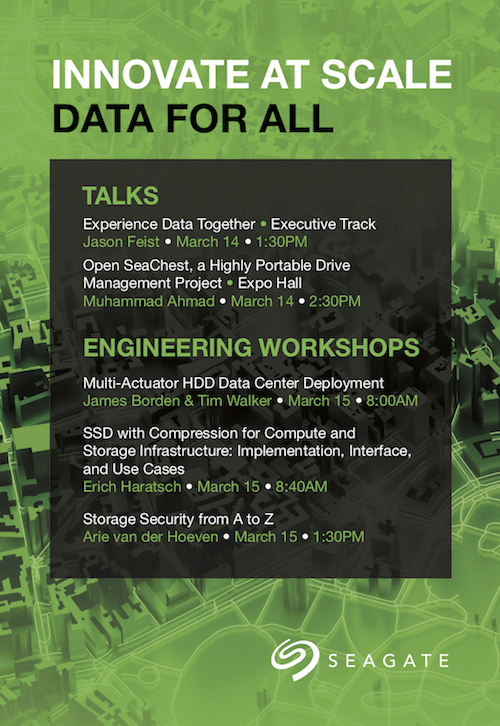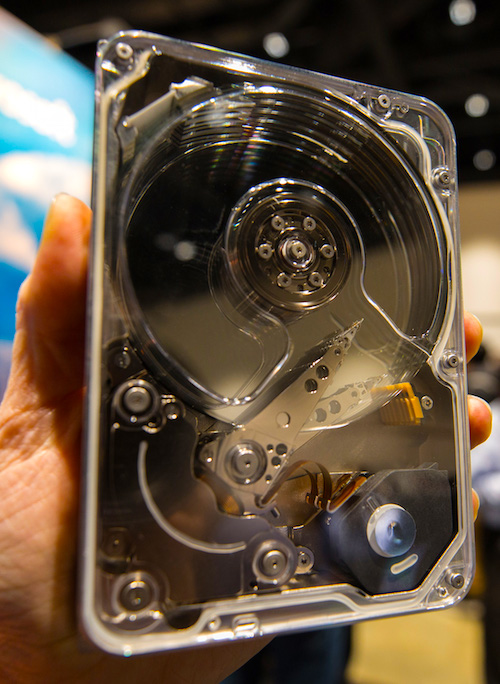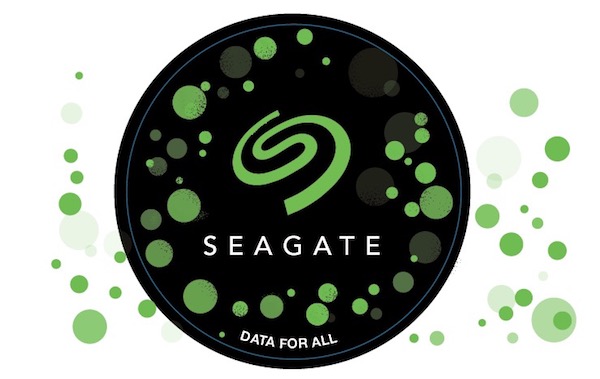Is your data flexible enough to enable your organization to innovate at scale? Modular, open data storage and management solutions are key to dynamic compute ecosystems.
That’s why at Seagate, as part of the Open Compute Project (OCP), we make it our mission to promote open and collaborative IT 4.0 cloud, edge and core datacenter infrastructure, and to help enable the OCP ecosystem by promoting quick development, efficient cost structures, agility, and standardization through data-driven partnerships.
This week we’re at the OCP Global Summit (March 14-15) along with more than 3,400 engineers, developers and decision makers aiming to help advance and support the open hardware ecosystem in, near and around the datacenter and beyond. OCP is focused on redesigning hardware technology to efficiently support the growing demands on compute infrastructure — its mission is to design, use, and enable mainstream delivery of the most efficient designs for scalable computing.
40 years of maximizing innovation through precision engineering and openly sharing ideas
 Four decades. That’s how long Seagate has been helping humanity maximize its potential by delivering world-class, precision-engineered data storage solutions. While maintaining our leadership in crafting the Datasphere one storage solution at a time, we believe that openly sharing ideas, specifications, and other intellectual property as part of the OCP community is important to maximizing innovation and reducing complexity in tech components. Seagate is proud to be here to help our partners preserve, perfect, and manage the information that means the most to them.
Four decades. That’s how long Seagate has been helping humanity maximize its potential by delivering world-class, precision-engineered data storage solutions. While maintaining our leadership in crafting the Datasphere one storage solution at a time, we believe that openly sharing ideas, specifications, and other intellectual property as part of the OCP community is important to maximizing innovation and reducing complexity in tech components. Seagate is proud to be here to help our partners preserve, perfect, and manage the information that means the most to them.
If you’ll be at the OCP Summit this week, stop in at our Booth B11 to hear advice and insights from our experts and learn about our new and ongoing OCP projects. You can also learn in depth about our portfolio — ranging from client, to enterprise, to hyperscale-optimized hard drives, SSDs and Systems, we allow for scale. We’re developing ways to support cloud-native and cloud-born applications needs. We’re enabling more and more data intelligence and usage, choosing to focus on data flow and security. With Seagate’s HAMR enabling breakthrough capacities and our first-of-a-kind MACH.2 dual actuator hard drive technology doubling the performance of traditional HDDs to enable maximum capacity use, we’ll continue providing storage cost reductions so that IoT thrives.
How to meet the challenge for cloud and edge growth
Growing demand for data, and for ever more advanced cloud and edge computing solutions, presents enormous challenges — and the resources and expertise to meet these challenges can become overwhelming for any one organization to address on its own. Seagate’s experts are on hand at the OCP Summit this week to discuss with you, and present formal talks on, a variety of high-level and specific development issues that must be addressed to meet these challenges:
Experience Data Together
As demand for data continues to explode, the global Datasphere will balloon to 175 zettabytes by 2025. Jason Feist from Seagate’s Office of the CTO will discuss the central role of cloud industry decision makers to promote breakthroughs in recording physics and innovations in areal density technology to support this growth. At the same time, the speed of access to data must continue to scale to improve interaction between the storage and compute tiers. And as new applications and devices at the edge further ramp up data creation, the data infrastructure must move data securely and with velocity. It’s vital for the cloud industry decision makers to take an active role to define pain points for the storage ecosystem, and provide solutions that optimize data’s value.
Multi-actuator HDD Deployment in Hyper-Scale Data Centers

Seagate MACH.2 dual actuator HDD with clear top at OCP
As cloud datacenters have deployed increasingly higher-capacity HDDs, some workloads have saturated the IOPs/TB limitations for these high capacity devices. Seagate has announced the first dual actuator HDD platform — using our MACH.2 technology — that effectively doubles the IOPs/TB for this device. Seagate Principal Cloud Architect James Borden and Technologist Tim Walker will provide an overview of the architecture, performance, and power characteristics of MACH.2 and its applicability in hyperscale environments.
They’ll cover the integration process and subsequent results of using dual actuator HDDs in the data center, including:
- The IOPS/TB deficit that dual actuator HDDs are meant to address.
- How these devices are integrated into the system, including direct access, RAID, scale out device mappers, and file systems.
- The resulting performance.
Open SeaChest, a Highly Portable Drive Management Project
Seagate Senior Engineering Manager Muhammad Ahmad will discuss an open source cross-platform project containing a collection of utilities written for storage products based on standard SAS, SATA, and NVMe specifications, allowing device diagnostics and management. The solution is portable, secure and non-disruptive, and integrates in diverse hardware platforms & operating systems to enable storage device management.
Problem: Need a highly portable, secure, non-disruptive software stack to enable various use cases of storage devices that are integrated in diverse hardware platforms & operating systems.
Solution: Open source (MPL) cross-platform project, written in C, as a collection of utilities & libraries for storage products based on the storage industry standard T10/T13/NVMe specifications that allows device diagnostics and management.
Storage Security from A to Z
Data security is becoming an increasingly lucrative target for cyber criminals. Worldwide revenue for data theft is estimated to be approaching $1 trillion per year. Storage vendors including Seagate have invested heavily in data security from secure supply chain, to securing data at rest, to end-of-life solutions like instant secure erase. These are all based on industry and government standards and best practices.
Arie van der Hoeven, Seagate Principal Product Manager and Cloud Ecosystem Lead, will discuss why collaboration with OCP Security efforts by device makers is essential to a full defense-in-depth data security strategy that defends against the possibility of malware or defects from privileged device related firmware and software.
SSD with Compression for the Compute and Storage Infrastructure: Implementation, Interface and Use Cases
Data compression within the SSD significantly reduces write amplification leading to increased performance and endurance. Alternatively, compression inside the SSD can be utilized to significantly increase user capacity. These benefits can in particular make high capacity QLC SSDs more attractive for the data center, cloud or edge infrastructure. However, compression inside SSDs is not widely available yet, and there is a lack of understanding of the implementation trade-offs and benefits. Erich Haratsch, Seagate Managing Technologist will describe the implementation, interface and use cases for compression inside SSDs. The goal of this presentation is to add compression-enabled SSD devices to the Open Compute Project by defining hardware and software interfaces, workloads, and use cases. This will provide the industry an additional attribute to consider when optimizing SSD requirements for specific workloads.
Our devices power the Data Age; our OCP partnership enables the best ideas in storage
As Jason Feist notes above, the sum of all data, whether created, captured, or replicated — the global Datasphere — will increase from 23 zettabytes in 2017 to 175 zettabytes by 2025, according to the IDC report Data Age. Our robust Guardian Series client and Exos and Nytro enterprise devices and systems meet cost, workload, and speed requirements, ensuring developers at each point of the ecosystem have what they need for content creation, storage, and analysis. We optimize metrics like read IOPs to enable SLA achievement in the cloud and we enable ingest metrics to ensure edge and IoT will capture and deliver all relevant content.
 And beyond our solution set, we’ll continue to work together with the OCP community to advance the architecture of the Data Age. Seagate hosts OCP workshops in our Fremont research facility. We publish white papers on use cases, showing how to use the tech via partnerships with companies like Microsoft, Facebook, and Netflix, so others can take advantage of this scale. We support and collaborate with the best ideas in storage. Our open source contributions via GitHub offers our tools to bolster analytics and management of fleets as grows to unprecedented volumes.
And beyond our solution set, we’ll continue to work together with the OCP community to advance the architecture of the Data Age. Seagate hosts OCP workshops in our Fremont research facility. We publish white papers on use cases, showing how to use the tech via partnerships with companies like Microsoft, Facebook, and Netflix, so others can take advantage of this scale. We support and collaborate with the best ideas in storage. Our open source contributions via GitHub offers our tools to bolster analytics and management of fleets as grows to unprecedented volumes.
By continuing to lead the way while also working together, we achieve better and faster results, have a bigger impact, and accelerate the technologies necessary to meet global challenges — technology, security, sustainability, and other social responsibilities — data for all.






